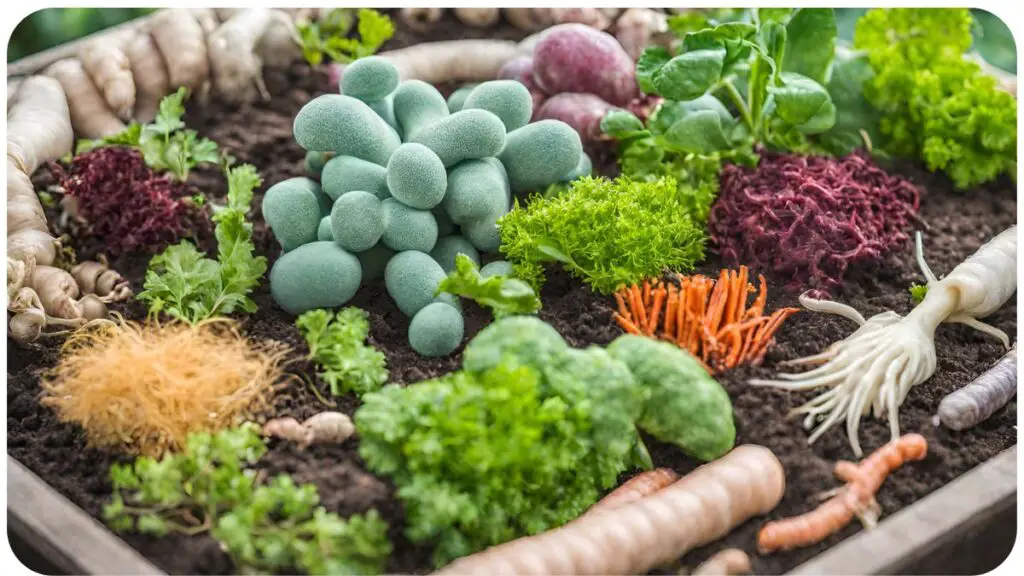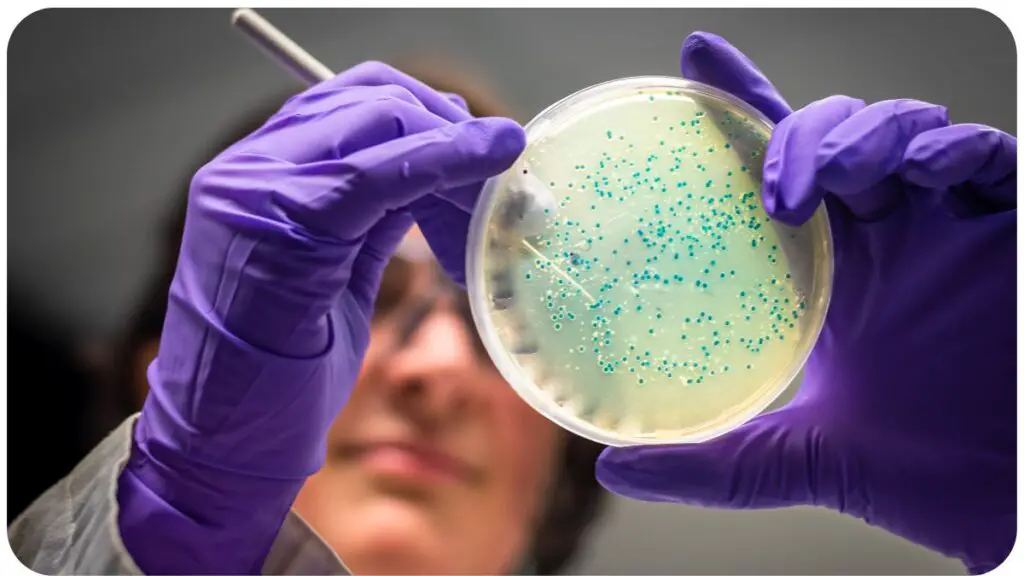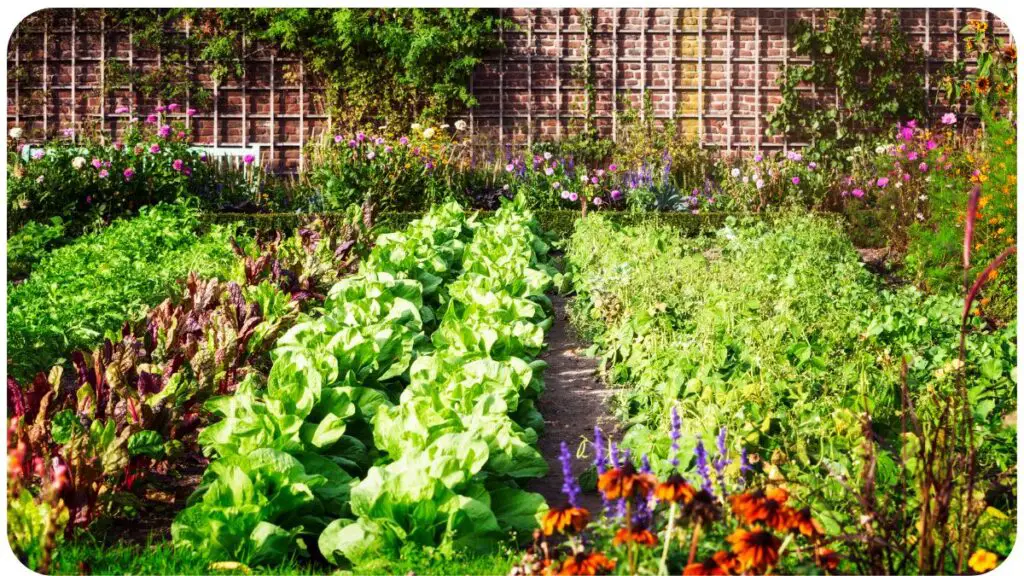Gardening isn’t just about planting seeds and watering them; it’s about creating a thriving ecosystem where plants can flourish. One essential aspect of gardening often overlooked is the microbiome.
In this article, we’ll explore the fascinating world of the garden microbiome, understand its significance, and learn how to leverage it for a healthier garden.
| Takeaways |
|---|
| 1. Prioritize soil health and microbiome diversity to create a thriving garden ecosystem. |
| 2. Implement sustainable gardening practices such as composting and mulching to enrich the soil with organic matter and beneficial microbes. |
| 3. Diversify plant species and practice companion planting to attract beneficial insects and promote natural pest control. |
| 4. Regularly monitor and assess the health of the garden microbiome through soil testing, microbial analysis, and visual observation. |
| 5. Share knowledge and experiences with fellow gardeners and participate in citizen science projects to contribute to microbiome research and conservation efforts. |
2. What is the Microbiome?

The microbiome refers to the diverse community of microorganisms, including bacteria, fungi, and other microscopic organisms, living in a particular environment. In the context of gardening, the garden microbiome encompasses the microorganisms present in the soil, around plant roots (rhizosphere), and within the plants themselves.
Organic gardening methods foster biodiversity, enriching the soil with essential nutrients and beneficial microorganisms. By prioritizing natural practices, gardens thrive sustainably and harmoniously with their ecosystem.” improve soil health
Table 1: Components of the Garden Microbiome
| Microbial Component | Description |
|---|---|
| Soil Microbes | Microorganisms residing in the soil |
| Rhizosphere Microbes | Microbes living in the vicinity of plant roots |
| Plant Microbiome | Microbes residing within the plant tissues |
The garden microbiome plays a crucial role in maintaining soil fertility, nutrient cycling, and plant health.
Importance of Microbiome in Gardens
The microbiome in gardens is not just a random assortment of microscopic organisms; it’s a dynamic ecosystem that profoundly influences plant health and overall garden productivity. Understanding its importance is key to cultivating a thriving garden.
One of the primary roles of the garden microbiome is nutrient cycling. Microbes in the soil break down organic matter, such as dead plants and animal residues, into essential nutrients like nitrogen, phosphorus, and potassium, which are then made available to plants. This nutrient recycling process is vital for sustaining plant growth and maintaining soil fertility over time.
Moreover, the microbiome helps in suppressing harmful pathogens and pests. Beneficial microorganisms compete with pathogens for space and resources, thereby reducing the incidence of plant diseases. Some microbes also produce compounds that repel or inhibit the growth of pests, acting as natural biopesticides.
Table 2: How Microbes Benefit Plants
| Microbial Function | Description |
|---|---|
| Nutrient Cycling | Breaking down organic matter and releasing essential nutrients for plant uptake |
| Disease Suppression | Competing with pathogens and producing antimicrobial compounds |
| Pest Resistance | Repelling or inhibiting the growth of garden pests |
| Stress Tolerance | Helping plants withstand environmental stresses such as drought or heat |
In addition to nutrient cycling and pest control, the garden microbiome also contributes to enhancing plant stress tolerance. Certain microbes form symbiotic relationships with plants, assisting them in coping with environmental stresses such as drought, heat, or salinity. These microbial partners help plants absorb water and nutrients more efficiently and produce stress-tolerance compounds.
Understanding the roles and functions of microbes in the garden microbiome underscores the importance of fostering a healthy microbial community for optimal plant growth and garden resilience. By nurturing beneficial microorganisms and creating conditions conducive to their proliferation, gardeners can harness the power of the microbiome to cultivate vibrant and productive gardens.
Compost, often termed ‘black gold’ by gardeners, acts as a nutrient-rich soil conditioner, enhancing fertility and supporting microbial activity. Its benefits extend beyond plant growth, promoting ecological balance and sustainability in vegetable gardens.” using compost in a vegetable garden
Components of the Garden Microbiome

To effectively manage and leverage the garden microbiome, it’s essential to understand its various components. The garden microbiome consists of distinct microbial communities inhabiting different niches within the garden ecosystem.
Soil Microbes
Soil microbes are the foundation of the garden microbiome. They include bacteria, fungi, archaea, and other microorganisms residing in the soil matrix. Soil microbes play crucial roles in nutrient cycling, organic matter decomposition, and soil structure maintenance.
Table 3: Soil Microbial Diversity
| Microbial Group | Role |
|---|---|
| Bacteria | Decompose organic matter, fix nitrogen |
| Fungi | Break down complex organic compounds |
| Archaea | Assist in nitrogen cycling |
| Protozoa | Regulate bacterial populations, nutrient cycling |
Rhizosphere Microbes
The rhizosphere is the narrow region of soil surrounding plant roots, where microbial activity is particularly abundant. Rhizosphere microbes interact closely with plant roots, forming symbiotic relationships that benefit both parties. These microbes play crucial roles in nutrient uptake, disease suppression, and plant growth promotion.
In Aerogarden systems, the absence of soil eliminates the risk of root rot, ensuring optimal nutrient absorption and plant health. This hydroponic method cultivates vibrant, flourishing plants without the common soil-borne diseases.” plants in Aerogarden don’t get root rot
Table 4: Rhizosphere Microbial Interactions
| Microbial Interaction | Description |
|---|---|
| Mycorrhizal Fungi | Form symbiotic relationships with plant roots, enhance nutrient uptake |
| Rhizobacteria | Produce growth-promoting hormones, suppress pathogens |
| Actinomycetes | Produce antibiotics, enhance soil structure |
Plant Microbiome
Inside plant tissues, a diverse community of microorganisms, known as the plant microbiome, resides. These microbes inhabit various plant parts, including leaves, stems, and roots, and contribute to plant health and resilience.
Table 5: Microbial Diversity in the Plant Microbiome
| Microbial Community | Location | Function |
|---|---|---|
| Endophytes | Inside plant tissues | Enhance stress tolerance, produce phytohormones |
| Epiphytes | On plant surfaces | Compete with pathogens, protect against diseases |
Understanding the distinct roles and interactions of these microbial components is essential for implementing effective strategies to promote a healthy garden microbiome. By nurturing beneficial microbes and creating conducive environments for their growth, gardeners can optimize plant health and productivity.
How Microbes Benefit Plants
The symbiotic relationship between plants and microbes is a cornerstone of ecological balance in the garden. Microbes play multifaceted roles in supporting plant growth, health, and resilience. Let’s delve deeper into how these microscopic allies benefit our beloved green companions.
Homegrown vegetables often boast superior flavor compared to store-bought counterparts due to factors like freshness, ripeness, and cultivation methods. The taste difference underscores the value of growing one’s produce, enriching culinary experiences and nutritional intake.” vegetables taste better in home gardens
One of the primary ways microbes benefit plants is through nutrient acquisition. Soil microbes, particularly mycorrhizal fungi, form intricate networks with plant roots, extending their reach for water and nutrients far beyond the root zone. In return, plants supply these fungi with sugars synthesized through photosynthesis. This symbiotic exchange enhances the plant’s ability to absorb essential nutrients, especially phosphorus and micronutrients, which may be scarce in the soil.
Table 6: Nutrient Acquisition by Plants through Microbial Associations
| Microbial Association | Nutrient Enhanced Uptake | Plant Benefits |
| Mycorrhizal Fungi | Phosphorus, Nitrogen, Micronutrients | Improved growth, stress tolerance |
| Nitrogen-fixing Bacteria | Nitrogen | Enhanced nitrogen availability, growth promotion |
Microbes also contribute to plant health by suppressing diseases and pests. Certain soil bacteria and fungi produce antibiotics and other antimicrobial compounds that inhibit the growth of pathogenic organisms. By outcompeting pathogens for space and resources, beneficial microbes help keep plant diseases in check, reducing the need for synthetic pesticides.
Table 7: Microbial Pest and Disease Control Mechanisms
| Microbial Mechanism | Description | Plant Benefits |
|---|---|---|
| Antibiotic Production | Production of antimicrobial compounds | Disease suppression, reduced pathogen load |
| Induced Systemic Resistance | Activation of plant defenses against pathogens | Enhanced disease resistance, improved plant immunity |
Moreover, microbes play a vital role in enhancing plant stress tolerance. During periods of environmental stress, such as drought or extreme temperatures, certain microbes produce compounds that help plants cope with adverse conditions. These microbial stress-tolerance enhancers enable plants to maintain their physiological functions and survive challenging environments.
Table 8: Microbial Contributions to Plant Stress Tolerance
| Microbial Contribution | Description | Plant Benefits |
|---|---|---|
| Osmoprotectants | Production of compounds that regulate osmotic balance | Enhanced drought tolerance, reduced water stress |
| Antioxidant Enzymes | Activation of antioxidant pathways | Reduced oxidative damage, improved resilience |
By harnessing the power of beneficial microbes, gardeners can create resilient ecosystems where plants thrive naturally, with minimal intervention. Incorporating microbial inoculants, such as mycorrhizal fungi and beneficial bacteria, into garden practices can amplify these microbial benefits and contribute to sustainable gardening practices.
Tips for Cultivating a Healthy Garden Microbiome

Now that we understand the importance of the garden microbiome and how microbes benefit plants, let’s explore practical strategies for nurturing a vibrant and diverse microbial community in your garden. Cultivating a healthy garden microbiome is not just about adding microbes to the soil; it’s about creating an environment where beneficial microorganisms can thrive and support plant growth effectively.
Companion planting strategically pairs compatible plant species to deter pests, enhance pollination, and optimize space utilization. This age-old technique fosters symbiotic relationships among plants, contributing to garden resilience and minimizing the need for chemical interventions.” companion planting an effective technique
Soil Preparation Techniques
Start by laying the groundwork for a healthy garden microbiome through proper soil preparation techniques. Avoid compacting the soil, as compacted soil restricts the movement of air, water, and nutrients, hindering microbial activity. Instead, practice techniques such as double-digging or using raised beds to loosen the soil and improve its structure.
Table 9: Soil Preparation Techniques for Healthy Microbiome
| Soil Preparation Technique | Description | Benefits |
|---|---|---|
| Double-Digging | Loosening soil to improve aeration and drainage | Enhanced microbial activity, root penetration |
| Raised Beds | Elevating soil to prevent compaction | Improved soil structure, water drainage |
Plant Diversity and Rotation
Diversify your garden by planting a variety of crops rather than monocultures. Different plants attract different microbes, promoting microbial diversity in the soil. Additionally, practice crop rotation to prevent the buildup of pests and diseases specific to certain plant families. Rotate crops annually to disrupt pest and disease cycles and maintain soil health.
Table 10: Benefits of Plant Diversity and Rotation
| Practice | Description | Benefits |
|---|---|---|
| Plant Diversity | Planting a variety of crops in the garden | Increased microbial diversity, pest control |
| Crop Rotation | Rotating crops to different locations or plant families | Reduced pest and disease pressure, soil fertility |
Organic Matter and Composting
Incorporate organic matter into your garden soil to provide a continuous food source for beneficial microbes. Compost kitchen scraps, yard waste, and other organic materials to enrich the soil with essential nutrients and microbial life. Organic matter also improves soil structure, moisture retention, and nutrient availability, creating an ideal habitat for microbes.
Table 11: Benefits of Organic Matter and Composting
| Practice | Description | Benefits |
|---|---|---|
| Adding Compost | Incorporating decomposed organic matter | Enhanced soil fertility, microbial activity |
| Mulching | Covering soil with organic materials | Weed suppression, moisture retention |
Avoiding Harmful Chemicals
Minimize the use of synthetic fertilizers, pesticides, and herbicides in your garden, as these chemicals can disrupt the balance of the microbiome and harm beneficial microbes. Opt for organic alternatives whenever possible, or use integrated pest management strategies to control pests and diseases while preserving microbial diversity.
Table 12: Harmful Effects of Synthetic Chemicals on Microbiome
| Chemical Type | Harmful Effects | Alternatives |
|---|---|---|
| Synthetic Fertilizers | Disrupt microbial balance, leach into waterways | Organic fertilizers, compost |
| Pesticides | Kill beneficial microbes, disrupt food chain | Integrated pest management practices |
By implementing these tips, you can create a nurturing environment for beneficial microbes and promote a healthy garden microbiome. Remember that building a robust microbial community takes time and patience, but the rewards in terms of improved plant health and productivity are well worth the effort.
Common Microbiome-related Garden Problems
Despite our best efforts, garden microbiome imbalances can sometimes lead to various challenges that hinder plant growth and productivity. Identifying and addressing these common microbiome-related issues is crucial for maintaining a healthy and thriving garden ecosystem. Let’s explore some of these challenges and strategies to mitigate them effectively.
Soil Compaction
Soil compaction occurs when soil particles are pressed together, reducing pore spaces and limiting air and water movement. Compacted soil restricts root growth and microbial activity, leading to poor plant health and stunted growth. Common causes of soil compaction include heavy foot traffic, machinery use, and improper soil management practices.
Table 13: Causes and Effects of Soil Compaction
| Cause | Effects |
|---|---|
| Heavy Foot Traffic | Reduced root penetration, poor water infiltration |
| Machinery Use | Soil compaction, restricted root growth |
| Improper Soil Management | Loss of soil structure, decreased microbial activity |
To alleviate soil compaction, aerate the soil using techniques such as core aeration or tilling. These methods help break up compacted soil layers, improve soil structure, and enhance microbial activity. Additionally, avoid walking or working in the garden when the soil is wet to prevent further compaction.
Poor Drainage
Inadequate drainage can lead to waterlogged soil conditions, depriving plant roots of oxygen and promoting the growth of anaerobic microbes. Poor drainage is often caused by compacted soil, improper grading, or heavy clay soil composition. Excess water retention in the soil can lead to root rot, nutrient leaching, and susceptibility to fungal diseases.
Table 14: Causes and Effects of Poor Drainage
| Cause | Effects |
|---|---|
| Compacted Soil | Reduced water infiltration, waterlogging |
| Improper Grading | Water pooling, soil erosion |
| Heavy Clay Soil | Slow water drainage, root suffocation |
To improve drainage, amend the soil with organic matter such as compost or peat moss to enhance soil structure and water infiltration. Installing drainage systems, such as French drains or swales, can also help divert excess water away from the garden area.
Pest and Disease Susceptibility
Imbalances in the garden microbiome can make plants more susceptible to pest infestations and diseases. Weak or stressed plants are more vulnerable to attacks from pests such as aphids, caterpillars, and mites, as well as fungal and bacterial diseases. Factors contributing to pest and disease susceptibility include poor soil health, nutrient deficiencies, and environmental stressors.
Table 15: Factors Contributing to Pest and Disease Susceptibility
| Factor | Effects |
|---|---|
| Poor Soil Health | Weak plant growth, reduced disease resistance |
| Nutrient Deficiencies | Reduced plant vigor, increased susceptibility |
| Environmental Stressors | Weakened plant defenses, increased pest pressure |
To mitigate pest and disease susceptibility, focus on promoting overall plant health through proper soil management, nutrient supplementation, and stress reduction techniques. Implement integrated pest management (IPM) strategies, such as companion planting, biological control agents, and cultural practices, to minimize pest and disease pressures while preserving the balance of the garden microbiome.
By addressing these common microbiome-related garden problems promptly and effectively, you can maintain a healthy and resilient garden ecosystem where plants thrive and flourish. Remember to monitor soil conditions regularly and adjust your gardening practices as needed to promote optimal microbial balance and plant health.
Techniques to Improve Garden Microbiome Health

Optimizing the health of the garden microbiome requires a multifaceted approach that incorporates various techniques to enhance microbial diversity and activity in the soil. By implementing these strategies, gardeners can create an environment conducive to the proliferation of beneficial microbes, ultimately fostering robust plant growth and resilience. Let’s explore some effective techniques for improving garden microbiome health:
Soil Aeration
Aeration is essential for maintaining healthy soil structure and promoting microbial activity. Compacted soil restricts the movement of air, water, and nutrients, leading to decreased microbial diversity and impaired plant growth. Aerating the soil helps alleviate compaction by creating channels for air and water infiltration, allowing beneficial microbes to thrive.
Table 16: Benefits of Soil Aeration
| Technique | Description | Benefits |
|---|---|---|
| Core Aeration | Removing small plugs of soil to relieve compaction | Improved soil structure, enhanced microbial activity |
| Tilling | Turning and loosening soil to increase aeration | Enhanced root penetration, nutrient uptake |
Mulching
Mulching is an effective technique for improving soil health and fostering microbial activity in the garden. Mulch helps regulate soil temperature, retain moisture, and suppress weeds, creating an ideal habitat for beneficial microbes. Organic mulches, such as shredded leaves, straw, or wood chips, gradually decompose, enriching the soil with organic matter and supporting microbial growth.
Table 17: Benefits of Mulching for Microbiome Health
| Mulching Benefits | Description | Effects |
|---|---|---|
| Soil Moisture Regulation | Conserving soil moisture and reducing evaporation | Enhanced microbial activity, improved nutrient cycling |
| Weed Suppression | Preventing weed growth and competition for resources | Reduced weed pressure, improved soil health |
Intercropping
Intercropping involves planting different crops together in the same garden bed, promoting biodiversity and enhancing soil microbiome diversity. Each plant species attracts specific microbes, contributing to a more diverse microbial community in the soil. Intercropping also helps suppress pests and diseases by disrupting their host plants and reducing monoculture susceptibility.
Table 18: Benefits of Intercropping for Microbiome Diversity
| Intercropping Benefits | Description | Effects |
|---|---|---|
| Biodiversity Promotion | Planting multiple crop species together | Increased microbial diversity, pest control |
| Nutrient Cycling | Improving nutrient availability through diverse root systems | Enhanced soil fertility, ecosystem resilience |
Using Biofertilizers and Biopesticides
Biofertilizers and biopesticides are organic alternatives to synthetic fertilizers and pesticides, containing beneficial microbes that enhance soil fertility and suppress pests and diseases. Biofertilizers, such as compost tea or microbial inoculants, introduce beneficial microorganisms into the soil, promoting nutrient cycling and plant growth.
Similarly, biopesticides, derived from naturally occurring microbes or their byproducts, help control pests and diseases while preserving the balance of the garden microbiome.
Table 19: Benefits of Biofertilizers and Biopesticides
| Bio-based Product | Description | Effects |
|---|---|---|
| Compost Tea | Liquid solution containing beneficial microbes | Improved soil fertility, plant health |
| Bacillus thuringiensis (Bt) | Naturally occurring bacteria that control insect pests | Pest control with minimal environmental impact |
By incorporating these techniques into your gardening practices, you can create a thriving ecosystem where beneficial microbes flourish, supporting healthy plant growth and productivity. Remember to prioritize sustainable and organic methods that preserve the balance of the garden microbiome and contribute to long-term soil health and fertility.
Monitoring and Assessing Garden Microbiome
To ensure the effectiveness of your efforts in promoting a healthy garden microbiome, it’s crucial to regularly monitor and assess the microbial community in your garden. Monitoring allows you to track changes in microbial diversity and abundance, identify potential issues, and make informed decisions to optimize microbiome health. Let’s explore some techniques for monitoring and assessing the garden microbiome:
Soil Testing
Soil testing is a valuable tool for assessing the health and fertility of your garden soil, including the microbial community. Soil tests can measure important parameters such as pH, nutrient levels, and microbial biomass, providing insights into soil microbial activity and diversity. Consider conducting regular soil tests using reputable laboratories to gauge the effectiveness of your microbiome management practices.
Table 20: Parameters Measured in Soil Testing for Microbiome Assessment
| Soil Parameter | Description | Importance |
|---|---|---|
| pH | Soil acidity or alkalinity level | Influences microbial activity, nutrient availability |
| Nutrient Levels | Concentrations of essential nutrients such as nitrogen, phosphorus, and potassium | Indicators of soil fertility, microbial biomass |
| Microbial Biomass | Quantification of microbial populations in the soil | Assess microbial activity and diversity |
Microbial Analysis
Advanced techniques such as DNA sequencing and microbial community profiling allow for detailed analysis of the garden microbiome composition. These methods identify specific microbial taxa present in the soil, providing insights into microbial diversity, abundance, and community structure. By analyzing microbial data, you can assess the impact of different gardening practices on the garden microbiome and adjust your approach accordingly.
Table 21: Methods for Microbial Analysis in Garden Soil
| Microbial Analysis Technique | Description | Benefits |
|---|---|---|
| DNA Sequencing | Identifying microbial taxa based on genetic markers | High resolution, comprehensive microbial profiling |
| Microbial Community Profiling | Analyzing microbial diversity and abundance using molecular techniques | Insights into community structure and dynamics |
Visual Observation
Regular visual inspection of your garden can also provide valuable information about the health of the microbiome. Look for signs of healthy soil, such as abundant earthworm activity, crumbly soil texture, and thriving plant growth. Conversely, symptoms of microbiome imbalances, such as wilting plants, yellowing leaves, or pest infestations, may indicate underlying issues that require attention.
Table 22: Signs of Healthy and Imbalanced Microbiome in the Garden
| Healthy Microbiome | Imbalanced Microbiome |
|---|---|
| Abundant earthworms | Reduced earthworm activity |
| Crumbly soil texture | Compacted or waterlogged soil |
| Thriving plant growth | Stunted growth, yellowing leaves |
Citizen Science Projects
Participating in citizen science projects focused on soil and microbiome research can provide valuable data while contributing to scientific knowledge. Many organizations and research institutions engage citizen scientists in collecting soil samples, conducting surveys, and monitoring microbiome dynamics in various environments. By joining these initiatives, you can contribute to ongoing research efforts and gain insights into the garden microbiome on a larger scale.
Table 23: Benefits of Participating in Citizen Science Projects for Microbiome Research
| Citizen Science Benefits | Description | Importance |
|---|---|---|
| Data Collection | Gathering large-scale data on microbiome dynamics | Contribute to scientific research |
| Community Engagement | Engaging with fellow gardeners and scientists | Collaboration, knowledge sharing |
By incorporating these monitoring and assessment techniques into your gardening routine, you can gain a deeper understanding of the garden microbiome and its response to various management practices. Armed with this knowledge, you can make informed decisions to optimize microbiome health and create a thriving garden ecosystem.
Case Studies: Successful Microbiome Management
Examining real-world examples of successful microbiome management in gardens can provide valuable insights and inspiration for implementing effective strategies in your own gardening endeavors. Let’s explore some case studies highlighting the impact of microbiome management on garden health and productivity:
Case Study 1: Organic Community Garden
In a bustling urban neighborhood, a group of passionate gardeners came together to establish an organic community garden in a vacant lot. Recognizing the importance of soil health and microbiome diversity, they implemented sustainable gardening practices to foster a thriving ecosystem.
Approach:
- Soil Enrichment: The gardeners enriched the soil with compost made from kitchen scraps, yard waste, and leaf litter, providing a continuous source of nutrients and beneficial microorganisms.
- Companion Planting: They practiced companion planting to diversify plant species and attract a variety of beneficial insects and microbes, promoting natural pest control and soil fertility.
- Minimal Disturbance: To preserve soil structure and microbial habitats, the gardeners minimized soil disturbance, opting for no-till or low-till gardening techniques.
Results:
- Vibrant Ecosystem: The community garden flourished with lush vegetation, abundant pollinators, and thriving microbial communities, creating a biodiverse and resilient ecosystem.
- Healthy Harvests: By prioritizing soil health and microbiome diversity, the gardeners enjoyed bountiful harvests of organic fruits, vegetables, and herbs, free from synthetic chemicals and pesticides.
- Community Engagement: The success of the organic community garden inspired neighboring residents to get involved in gardening, fostering a sense of community and environmental stewardship.
Case Study 2: Regenerative Farming Operation
On a family-owned farm in rural countryside, a farmer embraced regenerative agriculture practices to rejuvenate degraded soils and improve farm productivity sustainably. By prioritizing soil health and microbiome management, the farmer transformed the farm into a thriving ecosystem.
Approach:
- Cover Cropping: The farmer implemented cover cropping rotations to protect soil from erosion, fix nitrogen, and enhance soil organic matter content, supporting microbial activity and diversity.
- Animal Integration: Livestock grazing and rotational grazing practices were introduced to promote soil aeration, nutrient cycling, and microbial inoculation, enriching soil fertility and structure.
- Biological Amendments: Compost teas, microbial inoculants, and biofertilizers were applied to replenish soil microbiomes, stimulate plant growth, and suppress pests and diseases naturally.
Results:
- Soil Regeneration: Over time, the farm’s soils underwent significant regeneration, with improved soil structure, increased water retention, and enhanced nutrient cycling, thanks to active microbial communities.
- Productivity Boost: The adoption of regenerative practices led to higher crop yields, healthier livestock, and reduced input costs, demonstrating the economic viability of sustainable farming methods.
- Environmental Benefits: By sequestering carbon in the soil, reducing chemical inputs, and promoting biodiversity, the regenerative farming operation contributed to climate resilience and environmental conservation.
Case Study 3: Urban Rooftop Garden
In a densely populated urban setting, a rooftop garden enthusiast transformed a barren rooftop space into a lush oasis of greenery and biodiversity. Despite space limitations, the rooftop gardener embraced microbiome management techniques to create a thriving garden ecosystem.
Approach:
- Container Gardening: Utilizing containers and raised beds, the rooftop gardener optimized soil composition and drainage, incorporating organic potting mixes enriched with compost and beneficial microbes.
- Vertical Gardening: Vertical gardening structures were installed to maximize growing space and diversity, allowing for the cultivation of a wide range of plants and attracting beneficial insects and pollinators.
- Water Conservation: Drip irrigation systems and rainwater harvesting techniques were employed to conserve water and minimize runoff, maintaining optimal soil moisture levels for microbial activity.
Results:
- Urban Oasis: The rooftop garden became a green haven amidst the concrete jungle, providing habitat for birds, bees, and butterflies, while mitigating urban heat island effects and improving air quality.
- Local Food Production: Fresh herbs, vegetables, and edible flowers were harvested year-round from the rooftop garden, contributing to local food security and community resilience.
- Educational Outreach: The rooftop gardener shared their experiences and knowledge through workshops, tours, and social media, inspiring others to create urban gardens and reconnect with nature.
Conclusion
These case studies illustrate the transformative impact of microbiome management on garden health, productivity, and sustainability. By prioritizing soil health, biodiversity, and ecological balance, gardeners can create resilient and vibrant ecosystems that benefit both people and the planet. Whether in community gardens, farms, or urban settings, the principles of microbiome management offer a blueprint for cultivating thriving gardens and fostering environmental stewardship.
Further Reading
- The Role of Microbiome in Garden Health: This research article explores the intricate relationship between the microbiome and garden health, highlighting the importance of microbial diversity in maintaining soil fertility and plant vitality.
- Microbiome in the Garden: This resource provides insights into the microbiome’s role in garden ecosystems, offering practical tips for enhancing soil microbiome diversity and promoting plant resilience.
- Understanding the Gut Microbiome: Delve into the fascinating world of the gut microbiome and its impact on human health, with insights from healthcare experts at the Cleveland Clinic.
FAQs
What is the microbiome and why is it important for gardens?
The microbiome refers to the diverse community of microorganisms living in a particular environment, such as soil or the human gut. In gardens, the microbiome plays a crucial role in nutrient cycling, disease suppression, and plant growth promotion.
How can I improve the microbiome in my garden?
You can improve the microbiome in your garden by practicing sustainable gardening techniques such as adding compost, minimizing soil disturbance, and diversifying plant species through companion planting.
What are the benefits of a healthy microbiome for plants?
A healthy microbiome in the garden promotes soil fertility, enhances nutrient uptake by plants, suppresses pests and diseases, and improves plant stress tolerance, ultimately leading to healthier and more productive plants.
How can I assess the health of the microbiome in my garden?
You can assess the health of the microbiome in your garden through soil testing, microbial analysis, visual observation of soil and plant health, and participation in citizen science projects focused on soil and microbiome research.
Are there any resources available for further reading on the microbiome and garden health?
Yes, several resources are available for further reading on the microbiome and garden health, including research articles, gardening websites, and educational materials from reputable organizations.

For 15 years, Hellen James has worked in the gardening industry as an expert and landscape designer. During her career, she has worked for a variety of businesses that specialize in landscaping and gardening from small firms to large corporations.

